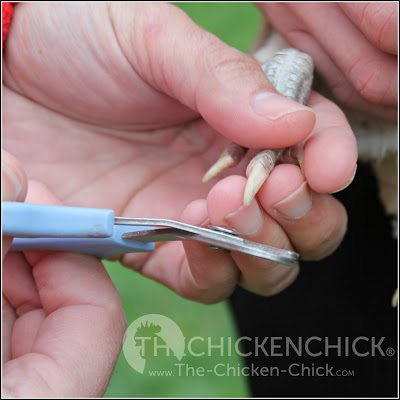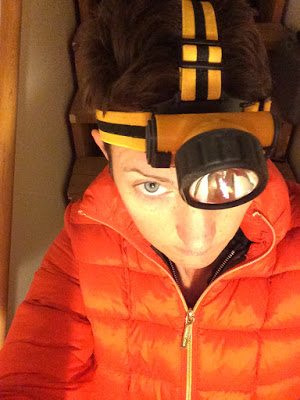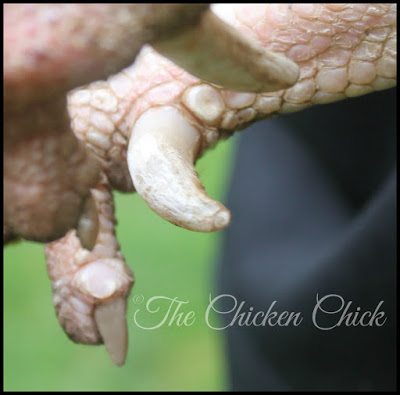Some breeds, including Silkies, have extra toes that grow in funky directions, requiring periodic nail clipping.
Equipment Needed:
- Styptic powder and paper towels on standby
- Dog nail clippers (guillotine style or plier-style clippers with a safety guard)
- OR a Dremmel tool (the noise and vibration are upsetting to many chickens, so I opt for nail clippers)
- Nail file or Nail Grinder tool (optional)
- Vetericyn Plus Poultry Wound Care spray: http://amzn.to/2jhxZDT
- A partner to hold the chicken.
A chicken’s nails contain a vein that will bleed if the nail is cut too far towards the toe, so keep styptic powder at the ready while trimming. In good light, the vein can usually be seen under the nail of chickens with light colored nails. Always trim conservatively to avoid nicking the vein.
Most chickens don’t care to be handled, so it is easiest to trim a chicken’s nails or spurs well after dark when they’re roosting and half asleep using a headlamp and a partner.
With a partner holding the chicken securely, hold the foot firmly in one hand, isolating the toenail to be trimmed and the nail clippers in the other. Trim 1/4-1/3 of the length of the nail. If the vein is nicked and bleeds, immediately dip the nail in styptic powder and hold gentle pressure on it with a paper towel until bleeding stops. File any sharp or jagged edges.
TRIMMING A ROOSTER’S SPURS
Spurs are horn-like, bony projections that grow out of the back of a rooster’s lower leg that are used for personal defense and flock protection. Think of the spur like a thumb that’s completely covered by a thick, sharp fingernail. A rooster’s spurs continue to grow just as his nails do and if left unchecked, can interfere with his ability to walk, cause injuries to him and others. To maintain a reasonable spur length, the spur cap can be removed or trimmed, however, when the hard outer layer of the spur is removed, the exposed bony tissue may bleed, is very sensitive, if not painful when touched, and is vulnerable to infection. For these reasons, I do not uncap my roosters’ spurs, preferring to trim them instead. The same method for trimming nails applies to spurs: steer clear of the live tissue underneath the spur cap, cutting only the first 1/4-1/3 of the projection with very sharp, large dog clippers, filing to dull any sharp edges. The spur caps will re-grow.
Kathy Shea Mormino
Affectionately known internationally as The Chicken Chick®, Kathy Shea Mormino shares a fun-loving, informative style to raising backyard chickens. …Read on


shop my SPONSORS







































How can you tell what the correct length is for chicken nails? Mine free-range in the backyard, and their nails haven’t seem to have been a problem. (We’ve never trimmed them before.) i would also like to be entered in the giveaway for the chicken brooder.
Thanks for all your helpful info.
We had 2 roosters that had spurs that grew SUPER FAST!!! I couldn’t believe how large, hard, and sharp they were. My poor girls were being torn to bits… We opted to remove the entire outer casing. They didn’t seem to care. Only a small amount of blood, and they walked away normally. But, I can tell you that their aggressiveness was reduced and the girls are actually regrowing some of their back feathers again…
Yes, as usual you are correct. I did additional searches and reading and found the information you reference. Those anecdotal descriptions of chicken death after administration of benzocaine ointments appear to be poor diagnosis. Thank you for your diligent guidance!
Apparently that information is vastly exaggerated. I have spoken with poultry vets who use lidocaine as nerve blocks before bumblefoot surgery. I suspect recommendations for house birds and similar may be the origin of the grain of truth.
The styptic powder sold on Amazon that your article links to includes benzocaine. I have read that all the -caine drugs should NOT be used on chickens. Is my info wrong? I will research it again, but in the meantime, maybe you can clarify. Thanks! I always LOVE your caring articles and magnificent photos.